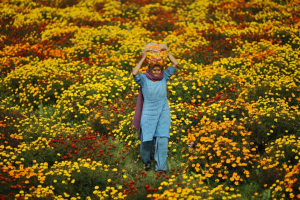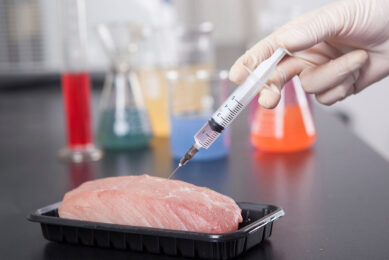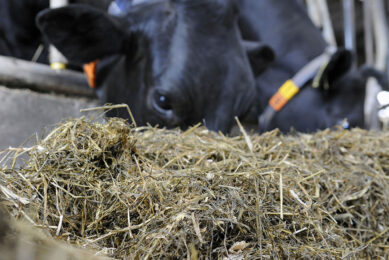New strategies for colouring broilers with natural pigments

Fluctuations in market availability of natural and synthetic pigments have generated a need for new strategies to optimise the use of available pigments and maintain colouration levels of demanded products. Yellow pigments can partially be replaced by red pigments to obtain the same desired result.
Chicken skin and egg yolk colour is determined by dietary carotenoids, mainly xanthophylls. Moreover, it bears mentioning their antioxidant and immunomodulatory properties, widely reported in the literature which may result in improved production parameters. Xanthophylls added to the diet are traditionally obtained from the petals of Marigold flowers (Tagetes erecta), which are very rich in these carotenoids, especially lutein and zeaxanthin. This source of xanthophylls can supplement or replace those originally derived from corn, alfalfa and other minor sources, thereby providing stable levels of xanthophylls in the diet, as xanthophyll content in raw materials is highly variable. These xanthophylls, commonly known as ‘yellow xanthophylls’, are responsible for the basic colour in chickens and eggs.In addition to yellow xanthophylls from natural origin, the so-called ‘red xanthophylls’ have also been used, typically being mainly capsanthin from paprika (Capsicum annum). A range of orange hues can be achieved by combining yellow and red xanthophylls, which allows adapting colour characteristics of chicken and eggs to the variety of consumer preferences on different markets.As an alternatively to natural pigments, synthetic products are also available such as beta-apo-8’-carotenal and ethyl ester of beta-apo-8-carotene for yellow hues, and canthaxanthin either alone or in combination with yellow pigment to get deep orange hues. In this context, the choice of products derived from marigold flowers and paprika is consolidated on the market in response to the growing consumer demands for products with a plainly natural profile.
Availability and pricing
The main drawback of natural products over synthetic ones is the risk of facing times of shortage. These shortages are dependent on different factors, mainly the weather, thereby conditioning crop production and harvesting. Moreover, the lack of natural pigments indirectly determines the availability and price of synthetic products. Thus, similarly to what happened in the mid 80’s, throughout 2010 and early 2011 we have experienced that the availability of natural yellow xanthophylls has been significantly influenced by a dramatic imbalance of supply and demand. In addition to the decrease of natural product available, we have experienced an increased global demand originated from a general trend to lower the use of corn in feed formulation. This situation has not only been observed in markets traditionally characterised by a high demand for pigments but on a global basis.Global consumption of natural pigments has grown by about 5% annually, maintaining a relatively stable trend in recent years. Consequently,the increased demand may be largely foreseen well in advance so as to ensure that the volume of grown product covers the demand. However, as the availability of harvested crop is dependent on a variety of causes, it can result in the demand being unmet.
In the case of the marigold flower, which is the main source of natural yellow xanthophylls, this is mostly grown in China and India, replacing other traditional producers such as Peru and Mexico. Because production is highly seasonal and basically restricted to certain geographical areas it makes the risk of crop failure greater, significantly affecting production availability throughout the year. In the case of synthetic xanthophylls, these are not necessarily subject to production variations throughout the year. However, the manufacturing capacity of factories is based on regular demands of the product. Overcapacity is not profitable to give response to temporary fluctuations. For this reason, the event of natural pigment shortage also causes a subsequent rise in the price of synthetic pigments. This occurrence has generated the need for new strategies to optimise the use of available pigments and maintain colouration levels of demanded products.
Partial substitution of yellow by red pigment
One strategy that has been proposed is the partial replacement of yellow pigment by red pigment. In this regard, it is worth noting that synthetic red pigments are made only with red xanthophylls. In contrast, the use of natural red pigment ensures also a percentage close to 15% of yellow xanthophylls.In the study described we evaluated the replacement of part of the natural yellow pigment by natural red in order to reach the yellow hue in footpads desired by consumers, which in addition is a reliable parameter to monitor pigmentation in shank and broiler skin (data not shown). This test was designed from a practical viewpoint, aimed at being a useful tool for producers when making decisions to optimise the use of natural pigments.In the study, increasing levels of natural red pigment combined with natural yellow to maintain different levels of total xanthophylls in broilers were provided. A total of 408 Ross-308 strain females were used. During the first 21 days of age, chicks received a feed based on wheat (47%) and corn (16%) as source of energy. From day 21 to slaughter at 43 days the basal diet consisted of cereal with no xanthophylls content (wheat, 39% barley, 26%). Both feeds had a guaranteed crude protein content of 20%.Different levels of yellow natural pigments rich in lutein (Capsantal EBS 30 NT) and red natural pigments rich in capsanthin (Capsantal FS 20 NT) were added to the basal diet. Thus, animals were assigned to 17 treatments, with a control group fed the basal diet and 16 treatments with combinations of four levels of substitution of red xanthophylls and four levels of total xanthophylls in feed were evaluated. Birds were housed in cages. The level of pigmentation was visually categorised according to Roche Yolk Colour Fan (RYCF). During the study, growth, feed intake and feed conversion of birds was also evaluated.
Results
As expected, production parameters were not affected by feeding treatments. No differences were observed between the four levels of total xanthophylls, as detailed in Table 1. Also, the values obtained for the various parameters remained within the normal range for this type of production. It is worth mentioning that according to European legislation, the maximum limit established in feed for all xanthophylls used in this study is 80 ppm. Therefore, the maximum dose used in our study remains within the authorised range in poultry.In reference to pigmentation obtained with the different levels of xanthophylls and the yellow/red ratios tested, differences were observed between most of the treatments (Table 2). Regarding total xanthophylls, the greatest differences were observed between the diets with 15 and 35 ppm total xanthophylls (Figure 1). Lower differences were found between the inclusion levels of 35, 55 and 75 ppm.At any case, and as expected, footpad pigmentation increased when increasing xanthophylls in the diet, although pigmentation was more marked with higher substitution rates of red xanthophylls. Thus, the replacement of 20% yellow xanthophylls by red xanthophylls showed both an increase of redness and a reduction of yellowness in the footpad measured with colorimeter (data not shown). Visual appreciation resulted in marked yellow-to-orange hues. The orange hue was especially marked when replacing 50% by adding 55 ppm of total xanthophylls. It was also noted that for diets with total xanthophylls lower than 20 ppm, the replacement of yellow by red pigment did not increase the hue intensity and even caused a slight colour faint. Colour loss was especially marked when 50% of the yellow pigment was substituted. Thus, for total xanthophyll levels above 20 ppm it is feasible to replace between 20% and 30% of yellow xanthophylls, whereas the replacement of 50% is viable when the total xanthophylls in the diet are above 30 ppm.
Therefore, results of substitution of lutein-rich pigment by a rich source of capsanthin are more apparent for chickens where levels of desired colour are medium to high. Thus, this strategy would not be suitable for markets where chickens are requested with moderate pigmentation levels in skin and shank.
Practical example
In general, we can assume that a good pigmentation level of the footpad is obtained between 6 and 8 according to RYCF. This represents a total content of xanthophylls in feed around 35-55 ppm (Figure 2). Taking this range of pigmentation we will conclude with an example. Let us suppose that our broiler chickens are fed a diet with 60% corn, which can make a total calculated contribution of xanthophylls from grain of 20-25 ppm, leaving 10 to 30 ppm of remaining xanthophylls to be supplemented by the inclusion of pigments.
According to results mentioned above, when dealing with levels of total xanthophylls higher than 35 ppm we could complete the remaining xanthophylls with 50% from marigold xanthophylls (mostly yellow) and 50% from paprika xanthophylls (mostly red). Using commercial products from the previous experiment, this would correspond to 250-750 ppm of Capsantal FS 20 NT together with 166-500 ppm of Capsantal EBS 30 NT (5-15 ppm of each xanthophyll [yellow and red]).
In the case where a white grain-based diet low in xanthophylls such as barley or wheat is used, the amount of xanthophylls to be supplemented obviously will be higher. Therefore, when starting with a diet with yellow xanthophylls levels lower than 20-25 ppm, it is not recommended to use high ratios of replacement with red xanthophylls, as the hue obtained without an adequate base of yellow would be lower than desired.Similarly, with an initial level of xanthophylls in the diet of 15 ppm, we would recommend a replacement of natural yellow xanthophylls no greater than 30%. In our case it would result in 13 to 27 yellow ppm and 6 to 13 red ppm, corresponding to 433 to 900 ppm of Capsantal 30 NT and 300 to 650 ppm of Capsantal FS 20 NT to reach the 35 to 55 ppm of total xanthophylls desired. References are available on request scarne@itpsa.com
Join 26,000+ subscribers
Subscribe to our newsletter to stay updated about all the need-to-know content in the feed sector, three times a week. Beheer
Beheer









 WP Admin
WP Admin  Bewerk bericht
Bewerk bericht